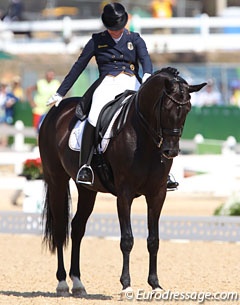
I have seen riders start daily ride getting straight into the work. I recently questioned someone about this and the person replied, "I am starting the warm-up." I couldn't help but wonder, before you begin warming up a horse don't you have to first see if he is responding to the very basic stop-go button? It’s not just a case of walking out and doing some loose rein walk and then trotting off into a rising trot stretch. Every single day is a new day, a new ride, and you must start every single lesson from square one.
This means that immediately after the free walk, at least ten minutes to get the horse loose, you take up the rein and begin with halt-walk transitions. You must first check to see if you have a stop-go button before you begin anything else. So you take up the rein gently and you come to halt. If the horse does not listen just with your seat, you give a small check on the rein, to remind him that he must respond to your seat. Then you ask the aid to walk off, first with a light touch, and if you do not get a response, then one tuck with both legs to get him to react.
Always remember never to punish the horse for a reaction, if he trots off do not pull his head off! A strong reaction is better than no reaction, so just gently bring him back to halt and ask again. Halt…Walk off…Was the leg aid light? Did the horse respond immediately? No, then halt and ask again. Halt, did the horse halt immediately? Was it just off my seat or did I need to use the rein too? Rein too, well then halt again. Still not listening, so one take on the rein, relax, ask again with the seat.
This may seem tedious, but this is the basis of everything else, and until you can get the horse moving off a light leg aid into walk, and off a seat aid to halt, then you cannot expect him to balance in the trot and canter.
Keep in mind that because your did it quickly yesterday, or all week, it doesn’t mean that the next day you can skip it. Everyday must begin right at the very beginning, which brings me to the next point. If you cannot get this, don’t just go "oh well, let's trot." It will not be a good lesson. It is far more productive to spend half an hour on the stop-go buttons, than half an hour plopping around the arena with a horse that is either asleep or running through the bridle. You might need to spend 30 minutes just on this. Alternatively you might come out and go to halt and straight away get it off the seat. Then you walk off, and get it straight away off a light leg. Great, start the lesson!
However, each day is a new day and it’s not something you can brush over and hope that the horse will start listening to your seat and leg later on. A top rider has a check list of what they must carry out before they get to the exercises, and a rider who is meticulous about achieving these basic elements every single day, is the rider that you never see pulling the horse's head off, because the horse is on the seat. Nor do you see this rider working harder than the horse, because the horse is forward and moving off a light leg. It didn’t just happen. It happened because every single ride this rider reminded his horse of the very basic aids required for everything else.
Unfortunately we see riders who bluff that part and then try to collect after a medium trot by quite literally pulling back so much so that their position goes at almost into a 45-degree angle to the horse's rump. Alternatively we see riders who come out of the test in a lather of sweat with a horse who pretty much took a ten minute holiday and looks quite refreshed really.
Every ride is a new one, and the stop-go button is a tool that riders have at their disposal. Perfect that button and the rest is easy!
by Sarah Warne - Photo © Astrid Appels